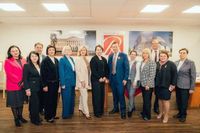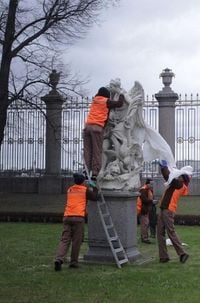In Kemerovo, a new public space named "Gostinaya Russkogo Muzeya" has officially opened, providing residents of Kuzbass with opportunities to engage in cultural and educational events organized by the Russian Museum. The grand opening, which coincided with the 130th anniversary of the Russian Museum, was attended by notable figures including Anton Pyatovskiy, Deputy Chairman of the Kuzbass Government, and representatives from the Russian Museum, such as Anna Tsvetkova, Deputy General Director for Development, Educational and Enlightenment Activities.
During the ceremony, Tsvetkova emphasized that the opening of "Gostinaya" marks a significant step in integrating the Russian Museum and its branch into the cultural fabric of the region. She stated, "The opening of 'Gostinaya' is an important step in integrating the Russian Museum and its branch into the cultural environment of the region." This new public space is designed to attract individuals of all ages, providing a venue for educational and enlightenment activities led by experts from the Russian Museum.
Pyatovskiy expressed gratitude to the Russian Museum for offering Kuzbass residents access to the rich heritage of Russian art, which he described as a source of spiritual strength. He confidently remarked, "'Gostinaya Russkogo Muzeya' will become a center for managing the 'poletami' of the Russian Museum's branch in Kemerovo." The space will host a variety of events, including lectures, seminars, master classes, creative meetings, discussions, and film screenings, all aimed at engaging a broad audience.
The first lecture held at "Gostinaya" was delivered by Maria Dmitrenko, an expert in project-based cultural and educational activities of the Russian Museum. Her presentation, titled "Russian Museum. History in the Ages," provided an intriguing overview of the history of the Mikhailovsky Palace and the establishment of the Russian Museum, which is recognized as the first state museum of Russian fine arts in the country.
In addition to the opening of "Gostinaya," the Russian Museum is also celebrating its 130th anniversary with a special ticket price of 130 rubles on April 24 and 25, 2025. This promotion allows visitors to explore all palaces and exhibitions of the Russian Museum, including the Mikhailovsky (Engineer) Castle, located at Sadovaya Street, 2. The anniversary date, April 25, is significant as it marks the founding of the museum, and the special pricing aims to increase accessibility for all.
Despite the main exhibitions being fully booked, tickets for evening sessions remain available. To accommodate visitors, the Mikhailovsky Castle will extend its operating hours on April 24, ensuring that more people can participate in the festivities. Those interested in attending are encouraged to purchase tickets in advance for either date to secure their entry.
Meanwhile, the Russian Museum is preparing for the unveiling of the sculptures in the Summer Garden, scheduled for April 18, 2025. Specialists will remove the wooden boxes and cotton fabric that protected the sculptures during the winter months. The opening of the gardens, following a drying period, will take place on May 1, 2025, allowing visitors to once again enjoy the iconic sculptural works of the Summer Garden.
This practice of covering sculptures during the winter is a long-standing tradition that has been observed for decades, aimed at preserving the statues from temperature fluctuations and condensation damage. The unveiling ceremony will occur in the presence of museum curators, restorers, and other specialists who will assess the condition of the artworks.
The tradition dates back to the 18th century during the reign of Anna Ioannovna when statues were wrapped in canvas. However, this method proved inadequate as the fabric would become wet and freeze. In the 1820s, sculptor Demut-Malinovsky proposed using wooden boxes, a technique that remains in use today.
During World War II, wooden shields were employed to protect the statues underground. The walls of the pits dug for storage were lined with shields, filled with sand, and the statues were placed inside and covered with additional shields. Remarkably, these unique sculptures survived the entire blockade of Leningrad. In the spring of 1945, they were retrieved and returned to their original locations.
Following the reconstruction of the garden, the original collection of marble sculptures was replaced with copies made of polymer marble, except for the "Nishtadtskiy Mir". The original sculptures, which adorned the Summer Garden for 300 years, have been housed in the Mikhailovsky Castle since 2011 to ensure their preservation. Although the copies are not the originals, they are independent works of high quality that require careful maintenance.
As part of the preparations for the spring and summer season, the Summer and Mikhailovsky Gardens have been closed since April 1, 2025, for annual drying. This closure is essential to restore the lawns and pathways, create a tranquil environment for birds during the nesting season, and complete all necessary preparations for welcoming guests.
Visitors can look forward to the reopening of the gardens on May 1, 2025, when they will be able to enjoy the beauty of the famous alleys, the unveiling of the sculptures, and the launching of fountains, all contributing to a vibrant cultural experience in the heart of Kemerovo.






